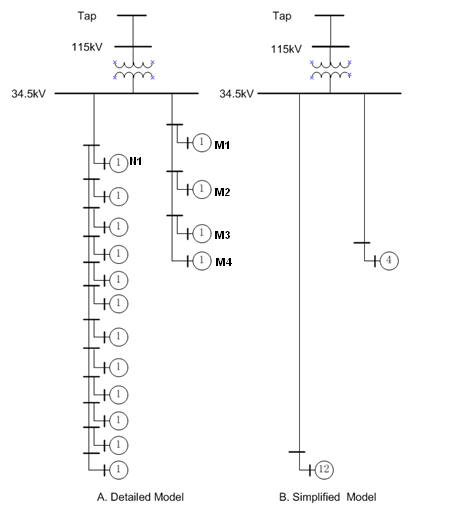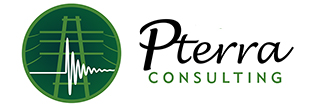As an increasing number of wind turbines are connected to the power system, more and more wind farm interconnection studies are requested. Usually a wind farm consists of tens of wind turbines and the interconnecting cables. The wind turbines are mostly the same type for each wind farm, but the cables interconnecting these wind turbines vary in length, capacity and configuration, depending on the farm design, terrain, easements, etc.
Top 3 Reasons
Here are the top 3 reasons a transmission analyst may need to avoid modeling each turbine and each cable in the wind farm for the interconnection study, including:
- It is laborious to setup the detailed model. For example, a 300 MW wind farm would comprise of 200 1.5-MW wind turbines interconnected at a distribution level voltage such as 34.5 kV in a feeder network similar to that of a suburban housing development.
- The simulation software for power flow, short circuit or stability analysis may not accommodate carrying detailed models for all the existing and proposed wind farms. To consider the dimensions, take the case of a system with some 5000 MW of installed wind capacity. Detailed modeling of the wind farms would require about 4000 turbine models, 5000 additional nodes and the same number of additional branches in the database.
- The detailed model requires representation of distribution level feeder circuits that increase the “spread” of branch impedances in the power flow model. “Spread” here refers to the range of impedances included in the database. (see further discussion about spread or diversity in the article, “Converging the Power Flow”). Too much spread can lead to difficulties in solving, or converging, the power flow.
In view of all the above reasons, it may be sufficient to aggregate groups of wind turbines into equivalents that capture their net impact on the transmission system.
Modeling Issues
For a typical interconnection study consisting of power flow calculation, transient stability and short circuit analysis, the aggregated wind farm model must effectively represent the behavior of the wind farm during
- steady-state operation;
- switching operations or short circuit occurrences;
- transient period following planned and unplanned events such as a fault, line trip, breaker reclose, or trip of a turbine.
The components of the wind farm that need to be considered in the aggregate modeling are:
- Steady-state, short circuit and stability models of the individual turbines. Typically, a farm will use the same type and manufacture of wind turbine throughout. Aggregating the individual turbines is straight-forward in this case. Most turbine models have the characteristics of aggregating by capacity. For example, GE 1.5 wind turbine generator model variables are in per unit on the generator MVA base. To model the aggregated unit, only the generator MVA base need be changed to the sum of the individual turbine MVAs. If the turbines are of different types, a more involved process for aggregating is required to obtain a good equivalent. In general, interconnection studies assume that each turbine sees the same wind speed; however, in reality, the wind diversity across a farm is such that some turbines may be below the wind threshold and delivering zero power while others may be at full power.
- Electrical layout of a wind farm. The layout of a wind farm looks much like a suburban housing development where the “houses” or in this case, the individual wind turbines, are spread out to minimize wind shadows and maximize wind capture. The turbines are interconnected by feeders that are arranged and optimized similar to a suburban distribution network, only in this case, they are part of the “collector” system. The more wind turbines there are in the farm, the more complex the collector system. For aggregation purposes, if the feeder is radial, one aggregate may be developed for the whole feeder, as shown in Figure 1. For the electrical impedance of the equivalent feeder, the two most common practices are: (a) use the sum of the feeder impedance to the farthest wind turbine or (b) use a rule-of-thumb for the equivalent impedance to be 1/3 of the total feeder impedance.
- Step-up transformer characteristics. These are generally modeled explicitly, even if the wind turbines are aggregated.
- Capacitor banks and static var devices. These are also modeled explicitly.

Figure 1A shows a detailed wind farm with 16 turbines arranged in two radial feeders, and in Figure 1B, a proposed equivalent with two aggregates, one for each feeder. In the figure, the numbers in the circles represent the total number of turbines at the corresponding buses. In the detailed model, each turbine is modeled exactly as it is electrically located in the wind farm, and each wind turbine bus has only one turbine connected. In the simplified model, two aggregated wind turbines are modeled at the remote end of each cable branch, one lumps together twelve wind turbines and the other, four wind turbines.
Next, we will look at the analytical requirements for the wind farm, and compare the results of the detailed and aggregate models. Please subscribe to this blog to ctach the next article.
Links: Pterra Home Page – business site for Pterra Consulting. Pterra Training Blog – updates on training courses for electric power topics. Pterra’s Facebook Page – for fun stuff such as industry news, photos, discussion, etc.
